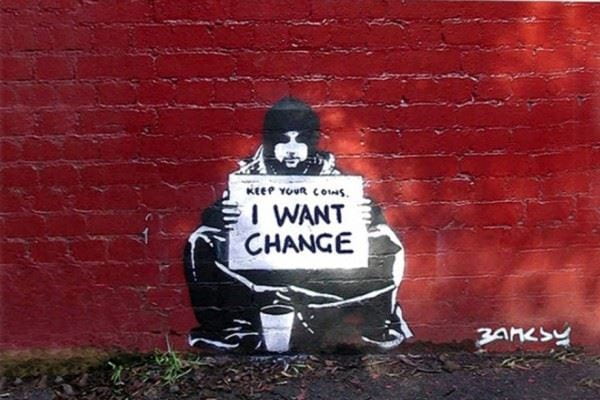BY GABRIELA CIPOLLA – ARTS & LEISURE EDITOR
“To be an artist is to believe in life,” quotes artist Henry Moore. “And that’s the entire point of art,” senior environmental studies major, Mariah Harrod, states, “it inspires people to believe in something and gives their passion to others.”
Harrod and her peers recently coordinated an “Artivism” festival in the warehouse on November 11th. Marrying self expression and environmental activism, the event was a unique chance for students to exhibit their artistic talents and discuss topics they are passionate about.
Mariah Harrod, Kasen Hollingsworth, and Nathan Carrier, in collaboration with the Centre Environmentalist Association, coordinated the event as their senior seminar for the Environmental Studies major. For many Centre students, senior seminar generally promises a dreaded inches-thick thesis written under the stress of graduate school applications and jobs searches. Harrod and her classmates, however, decided that the culmination of their studies would be one that the student body would not soon forget.
Kasen Hollingsworth explains that the group’s goal was, “To unite all different sects of the Centre community in one beautiful environment to express the idea that facts, protests, riots, petitions, etc. are not the only way to fight for change.”
The exhibits at the event were undoubtedly powerful and unique. Hollingsworth describes Evan Hintz’s piece in admiring detail: “He crafted mushrooms of various sizes and made a gorgeous, textured wall piece. It was inspired by mushrooms growing on the wall of a pitch-black cave–exemplifying the fact that life can truly be found anywhere.”
These displays of of honesty and raw feeling, such as Griffin Mason’s poem, “I Used to Watch the News” describing his exhausted perception of “depressing” and “biased” news, speak to profound emotions and turmoil that we all experience, but may not know how to express.
Hollingsworth and Harrod both expressed a desire to turn away from negative stereotypes associated with activism that conjure up images of “dirty hippies,” as Hollingsworth specifically notes. More importantly, he mentions that, “Through art, we were able to express support for environmental and social issues–something many individuals would never get the chance to do. Traditional activism can be a major turn-off for some parties.”
In the midst of one the most divisive periods in American politics, the global mindset that Artivism promotes is more crucial than ever. Although the event and its exhibits were planned before last week’s political events, the message of solidarity in peace and connectedness through shared passion seems almost painfully pertinent in the last several days.
“The inspiration for the festival,” Harrod mentions, “came from a conference called Power Shift Midwest.” Power Shift is an organization focused on equipping young activists with the organizational and strategic skills necessary to push the world to a “just, clean-energy powered future.” After attending the Midwest conference, Harrod found that the most effective method in achieving change was, “to make people friends again.”
According to Harrod, the uniqueness of the conference came from the vulnerability of its attendees. Discussing and rallying around environmental protection and political action forced Harrod and her peers to go beyond the barriers of political affiliation, religion, and even field of study.
This sentiment was clearly portrayed in the Artivism Festival here at Centre. By displaying the parts of students that made them most vulnerable, their personal artistic expression, the connectedness that Harrod was trying to emulate from Power Shift was most definitely perceived by its attendees. “Art is inclusive and is something by its very nature that is communal,” she expresses.
Alex Hibbs, a senior, found that while the event was the brainchild of three Environmental Studies majors, attendees were willing to discuss any aspect of activism that was important to them. “This kind of openness was surprising to me,” Hibbs mentions, “but important to the implicit message of the festival: care about something and then do something to produce the change you desire.”
Hibbs offers a sage and pertinent remark in response to her perception of the event: “I think it’s useful to think of the Artivism Festival in light of other student efforts happening around campus. This festival was not simply about art and environmentalism…it was more directly focused on inspiring people, enabling people, and turning passions into productivity.”
The quiet, studious confines of the college, often deemed the “Centre Bubble”, has a habit of quickly normalizing or letting complacency take over after a turbulent event has occurred. The fact is, it is easier to swallow the fire within you when the next week has tests, papers, and extra-curriculars abound in store.
Our role as global citizens is just as important as our role as students, but it is taxing to balance so many responsibilities. This event challenged students to push their personal boundaries and strive to make the change that we crave but often respond to with, “tomorrow.”
The Artivism Festival awakened something within its coordinators, Harrod, Hollingsworth, and Carrier, and hopefully it accomplished the same for those who attended. During an especially discordant global period, the cathartic and motivating passion of artivism holds a lesson that we would all do well to remember, imparted by Mariah Harrod: “You don’t express art for yourself, it is for everyone around you.” Our lives and our art, whatever form it takes, should be our message to the world; a message that reflects our values and respects the values of those who observe it.
